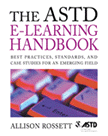
Dr.
Allison Rossett ,
long time Professor of Educational Technology at San Diego State
University, is a member of the elite Training
magazine HRD Hall of Fame. A consultant in the design, development
and evaluation of training systems, she often concentrates on
those that involve technology systems. Rossett is an irreverent
native New Yorker who does keynote speeches in this country and
abroad about engagement in online learning, performance systems,
and needs analysis. Rossett is the editor of The ASTD E-Learning
Handbook: Best Practices, Strategies and Case Studies for an Emerging
Field, published in early 2002. Her 2001 book and web site are
Beyond the Podium: Delivering Training and Performance to a Digital
World, http://www.pfeiffer.com/go/BTP.
Rossett
authored the award-winning book and web site: First Things Fast:
A Handbook for Performance Analysis, www.jbp.com/rossett.html.
Rossett also received the Association for Educational Communications
and Technology, Division of Instructional Development, Book
of the Year Award in 1989 for Training Needs Assessment, published
by Educational Technology Publications. Her book, A Handbook
of Job Aids, published by Jossey-Bass, won the International
Society for Performance and Instruction’s 1991 top book award.
Allison
has published dozens of articles, edited journals, offered seminars,
coached and advised business and government leaders, evaluated
programs and managed corporate contracts and federal and state
grants. Her article, "Confessions of a Web Dropout,"
published in Training magazine in August, 2000, points to problems
with persistence in online learning.
|
Distance-Educator.com
asked Dr. Rossett to provide us the preface to The ASTD E-Learning
Handbook: Best Practices, Strategies and Case Studies for an Emerging
Field to introduce the book to you:
As little
as one year ago, this would have been a different book. More authors
would have gushed with enthusiasm. That Handbook would have sung the
praises of e-learning, touting the benefits, and encouraging participation
in this great and inspiring adventure.
But this
Handbook has a more muted tone. While many authors remain ecstatic
about e-learning, myself included, we are cautiously so. We admit
the challenges and describe strategies to increase odds for success.
We attend to the nitty-gritty details associated with topics like
converting classroom training to the web, collaborating with IT, standards,
objects, framing questions for online communities, games that teach,
fertilizing the culture, and expanding the definition of e-learning
to include knowledge management.
My purpose
here is to support people who have begun to move beyond their e-learning
honeymoons. No longer besotted with the e-learning concept and technology,
readers and writers are ready for the negotiations, associations and
evaluations that come next. Here you will find perspectives, guidance
and tools for those who are ready to do the heavy lifting involved
in translating e-learning promises into performance.
What’s
a learning professional to do? What do we know about what constitutes
effective e-learning? Where do e-learning investments go awry? How
do we align organizations around e-learning? What’s next? How
do we take advantage of so many new opportunities without being swept
under?
Enter
the ASTD E-learning Handbook. This book gathers the best ideas, strategies,
research and examples together in one place, with the promise of a
new collection following in the near future. Designed to save professionals
the trouble of reading dozens of trade periodicals, this Handbook
provides current, cutting-edge thinking, approaches and cases. Here
we’ve gathered recent print and online articles and white papers,
and added fresh commentary and ideas from leading sources in the industry.
Note the resource directory intened to lure professionals into further
study on their own.What
will you find in the ASTD E-Learning Handbook?
- A
focus on your questions. The book is for you if you’ve been wondering:
What is e-learning and why all the excitement? What are others doing?
How is the role of the training and development professional changed
and changing? What do I need to know and do? Where can I go to continue
my education? Where can I go for references and examples? Are there
new ways to think about e-learning, ways that take me beyond a classroom
metaphor? What does e-learning have to do with e-commerce? What
is blended learning? Is anybody in my industry doing anything like
this?
- A
focus on what might keep you up at night. The gap between what is
promised and delivered can be daunting. At best, the authors in
the Handbook will help you sleep through the night. At the least,
they’ll give you a heads-up on the vexing challenges to come.
How do I execute on the promises associated with e-learning? How
can I measure return on investment from e-learning? How can I create
online questions and enhance online community? How do I pick effective
software? What are the myths surrounding e-learning and how do I
work around them?
- A
comprehensive e-learning sourcebook. The Handbook is divided into
six sections. The first section tours the current state of e-learning,
including articles that paint pictures about involvement, persistence
and satisfaction. Section II is all about developing great e-learning,
including guidance for vendors attempting to create learning software,
and for internal professionals who must make decisions about which
software to choose. Section III focuses on management and implementation.
Recognizing the challenges, authors describe what it takes to implement
e-learning systems and technologies in real and complex organizations.
In Section IV we ask a pivotal question: Is e-learning too good
to be true? Section V tends to our seed corn by providing new directions
and resources for the professional development of the e-learning
professional. The last section, Section VI, serves up many case
studies in organizations as diverse as technology companies, higher
education and government. The Handbook concludes with a resource
section and index.
- Many
renowned experts. Marc Rosenberg, Elliott Maisie, Jack Phillips,
Brandon Hall, William Horton, Gloria Gery, and Wayne Hodgins have
written original or revised pieces for the Handbook. I’m thrilled
to have their newest thinking on topics like standards, games and
e-learning, return on investment, blended learning and the culture
and communications essential to successful implementation.
- Many
familiar authors. When I set out to find recent articles that would
add value to the book, recognizable and worthy sources popped up.
You’ll find Patricia Galagan, Sarah Fister Gale, Zane Berge,
James Moshinskie, Tom Barron, Albert Ingram, Patti Shank, Marc Prensky,
Karl Albrecht, Rob Foshay, Dean Spitzer and Gary Dickelman. You’ve
read their work in Training and Development, Performance Improvement,
Knowledge Management, and others; you’ll see some of the best
recent efforts reprinted here.
- Many
new voices. Meet Warren Longmire, Rebecca Vaughan Frazee, Andrea
and James Young, Chris Volkl, Nory Jones, David Wiley, and Bob Hoffman.
I made a concerted effort to invite recent graduates and emerging
professionals into the project.
- Many
diverse cases. The Handbook includes stories about Cisco, Oracle,
Royal Bank of Canada, Pfizer and Buckman Labs, to name just a few.
You’ll also find sales training via technology, e-learning
for orientation, project management training online through the
use of an object-oriented approach, and the shift of soft skills
training to a more blended and technology inclusive approach.
- A
tool for professional development. The Handbook is designed to encourage
dialogue, reflection, planning and action surrounding e-learning.
Rich resources will help orient and educate practitioners and executives
about e-learning.
- American,
but with some international flavor. Most authors are Americans,
but not all. There is an article, for example, that describes e-learning
in Europe. I favored articles that included global perspectives,
and sought examples and cases from organizations that do their business
across the world. The topics covered here, from e-learning persistence
to online games to collaboration to cognitive distribution to knowledge
management, are as important to a Dutch or Brazilian training professional
as to a North American.
The Handbook
is meant to inform, coach, entice, caution, and encourage. Articles
were chosen and crafted to help professionals cope with vendors that
promise vast multiples of improved cognition via e-learning, OR quotes
like Clifford Stoll’s: “E-learning is a terrific way to
get a third-rate education.” We acknowledge the hype on both
sides of the e-learning coin, from those who promise that e-learning
will cure all that ails your organization, and those who see a devil
trying to take away classroom training. This Handbook attempts to
help you move towards that fruitful, productive middle ground.
|









